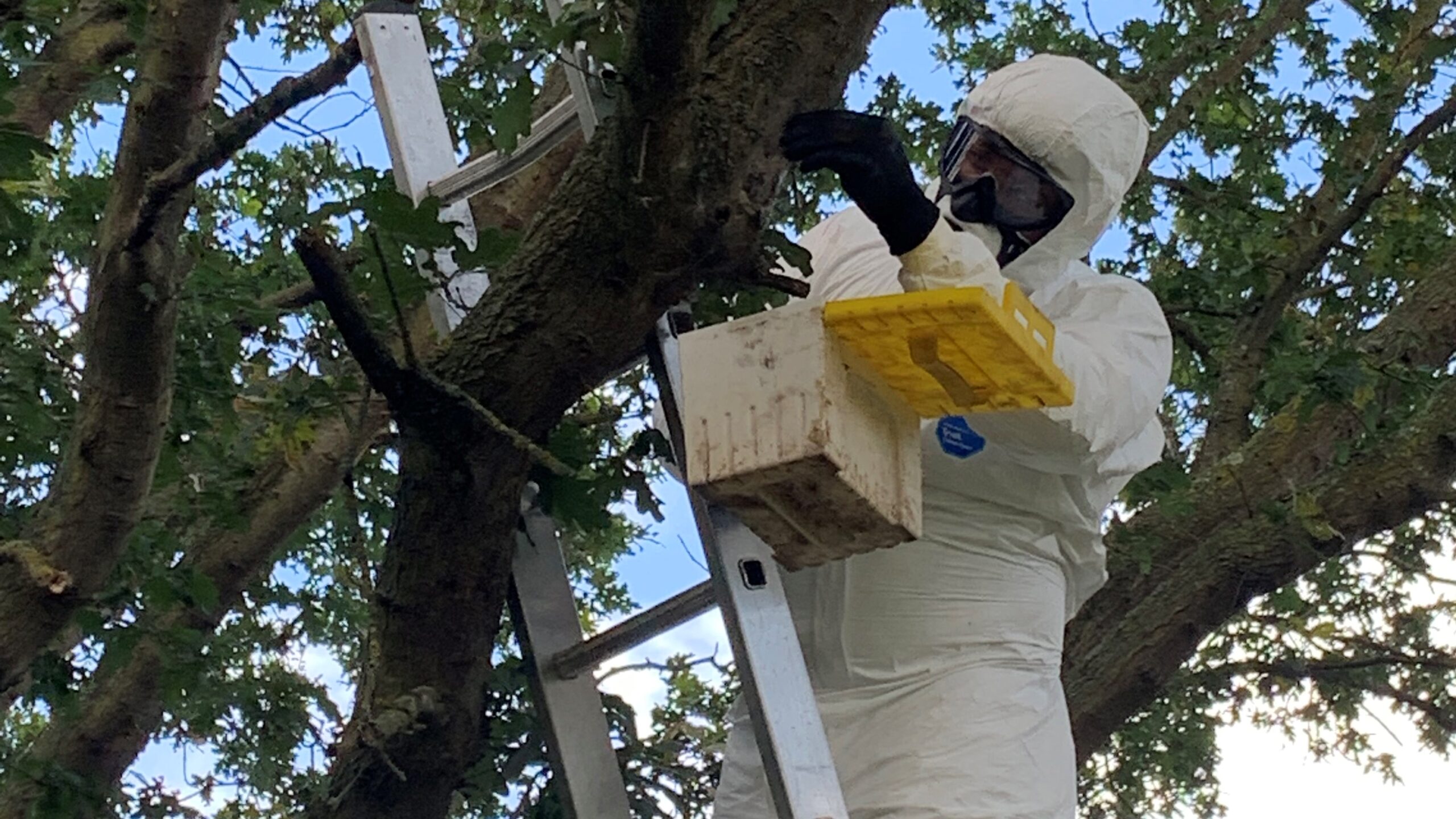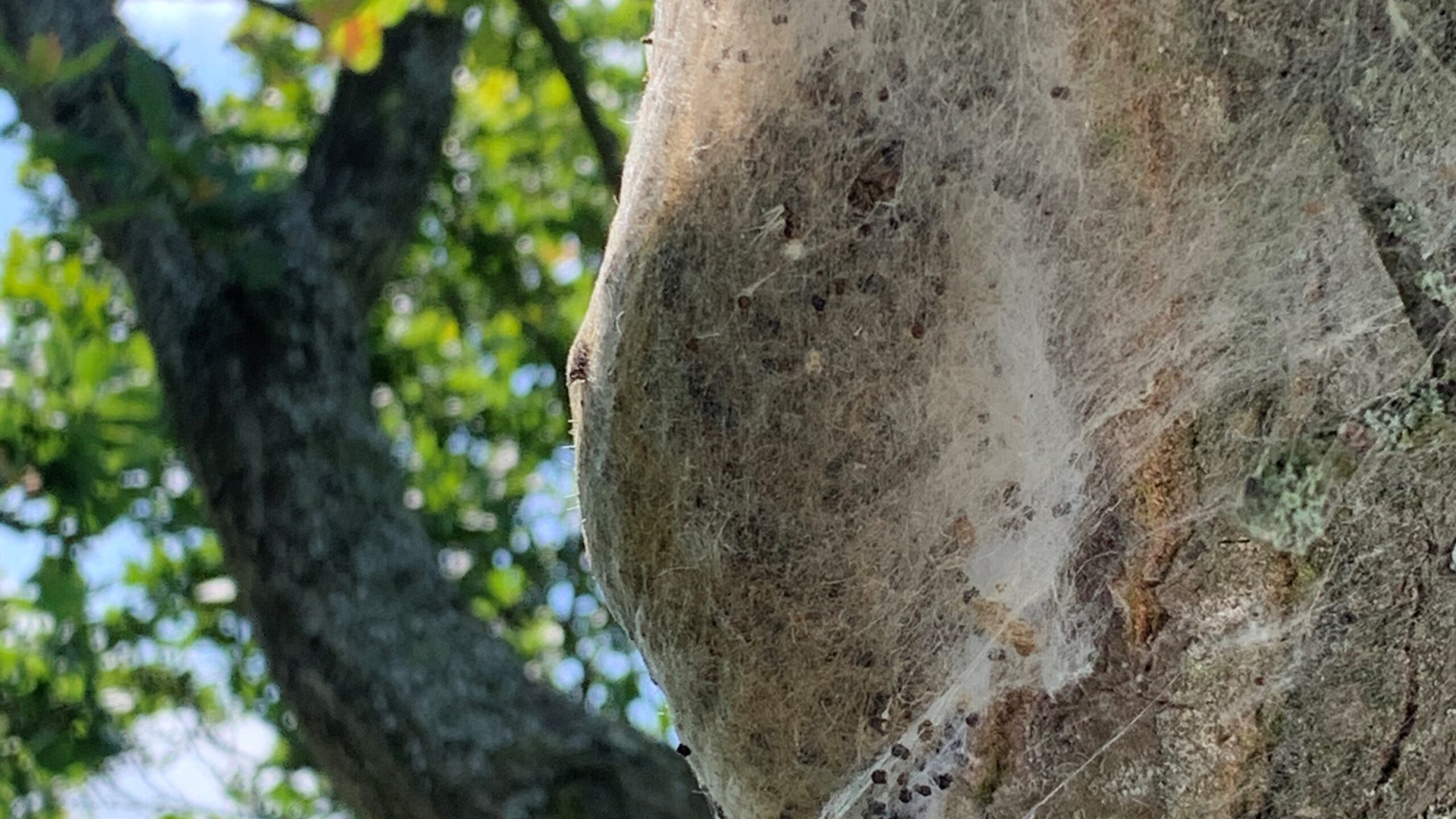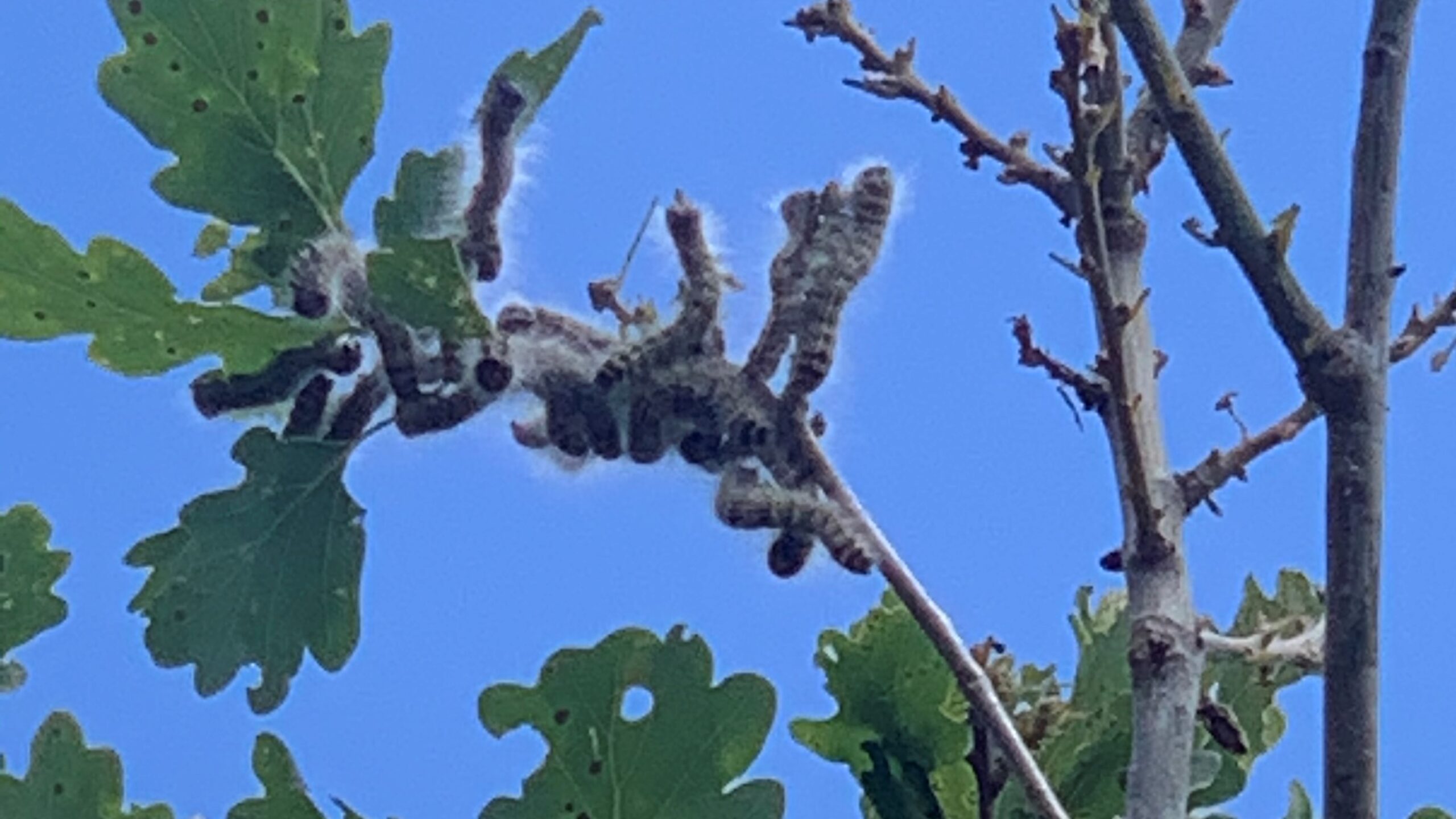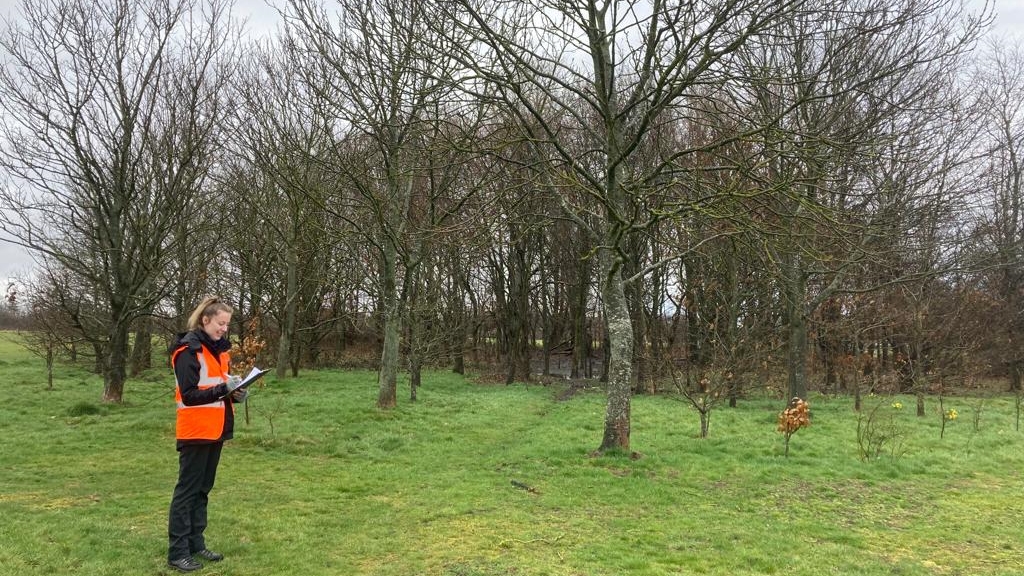Facing up to Oak Processionary Moth
Victoria Jackson is part of the Consultancy team at Maydencroft. Her work involves oak processionary moth (OPM) surveys and writing OPM Strategies and Management Plans. Here she discusses answers to questions those with woodlands in the affected areas may need to know.

Above: Safe removal: Credit Maydencroft
Oak Processionary Moth (OPM) is currently found in London and the South East.
It is regulated as a quarantined pest and there are restrictions on the import and movement of oak trees into and around the UK. Landowners have a legal duty to take reasonable care to avoid acts or omissions that may cause a foreseeable risk of injury, harm or loss to a person or property. This would apply to woodlands with OPM that has public access.
The Forestry Commission operational boundaries have recently been expanded. The actions required are dependent on which zone a site is located. A map can be found on the government’s OPM webpage here.
Maydencroft is an ecologically focussed company providing forestry, landscaping, estate management, nature recovery and many other environmental serves. It also provides OPM nest removal and OPM training courses.
Here Victoria discusses the answers to questions those with woodlands in the affected areas may need to know.
Good to know

OPM nest on trunk: Credit Maydencroft
- OPM caterpillars produce hairs as a defence mechanism. These hairs (urticating hairs) can cause skin rashes, conjunctivitis and respiratory problems in humans and animals;
- OPM caterpillars are specialist herbivores, eating only oak leaves. They can complete their life cycle on the UK’s native oaks (pedunculate and sessile) as well as Turkey oak and holm oak;
- In the UK, many of OPM’s natural predators and parasitoids are absent. These would control population numbers in its native range;
- The best time of year to spot OPM is early summer, when the caterpillars are larger and new nests are built;
- Removing and destroying nests between late June and early August is the most effective time. The caterpillars will be pupating in the nest and none will be out feeding;
- Spent nests are full of stinging hairs. These may fall to the ground and release the hairs into the environment at any time of year. It has been suggested the hairs can be active for up to 10 years;
- Pesticides can impact non-target species of moth and butterfly that feed on oak trees at a similar time of year to OPM. Nature-based solutions, such as modifying the environment so it is less suitable for OPM and encouraging natural predators and parasitoids should be encouraged wherever feasible.
Frequently Asked Questions – about OPM

Above: OPM on twigs. Credit Maydencroft
OPM caterpillars produce urticating hairs as a defence mechanism. They are released when the caterpillars feel threatened and are shed in nests that the caterpillars form to pupate. These hairs can cause skin rashes, conjunctivitis and respiratory problems in humans and animals. Health problems can occur even when there is no direct contact with the caterpillars, as hairs can break off easily and be transported in the wind.
OPM caterpillars are also specialist herbivores, eating only oak leaves. This can weaken the tree and leave it vulnerable to other stresses.
OPM is native to central and southern Europe. OPM caterpillars first arrived in London in 2005 from the trade of live oak trees. In the UK, many of OPM’s natural predators and parasitoids are absent. These would control population numbers in its native range.
Since 2010, it has been considered unfeasible to eradicate OPM from the UK. Efforts are now focused on containing the spread and managing risk.
OPM can complete their life cycle on the UK’s native oaks (pedunculate and sessile), as well as Turkey oak and holm oak.
They can sometimes be found on other trees when population numbers are high. They have been observed ‘processing’ on the ground between these trees. However, OPM cannot complete their life cycle on trees other than oaks.
It is possible for OPM caterpillars and nests to be found on objects close to or on oak trees, such as bins, letterboxes and bird boxes.
Nests are domed or tent-like in shape. They begin white and silken but soon turn brown and messy. The nests range in size from golf ball to rugby ball
I find it can sometimes take a while to ‘get your eye in’. Firstly, I would recommend taking a pair of binoculars. They not only enable you to view the high branches of trees, but also ensure you keep some distance away. The best time of year to spot OPM is early summer, when the caterpillars are larger and new nests are built. Winter can also be a good time of year to spot old nests, when there are no leaves on the tree.
OPM nests can be found at all heights on a tree, and are most likely positioned on the underside of large limbs. It is worth looking at the tree from several angles.
Although OPM nests start white, they discolour over the season which can make them harder to spot. Older and larger nests in particular can dislodge and fall to the ground, so I would always recommend checking the ground first before getting too close to a tree.
There can also be more than one nest on a tree. We counted and removed over 100 nests from a single oak tree in Peckham!
OPM nests can remain in a tree for many months after the moths have flown, but can be dislodged by high winds or collapse under their own weight.
The greatest risk period is May to July when caterpillars develop the urticating hairs and come down to the lower parts of the tree to feed and build nests.
Spent nests are full of stinging hairs, and they may fall to the ground and release the hairs into the environment at any time of year. It has been suggested the hairs can be active for up to 10 years.
Forestry workers and arborists have the greatest occupational risk, as they are likely to come into contact with OPM or their nests at any time of the year.
No, the urticating hairs are only found on the caterpillars, which are then shed in the nests.
OPM tend to favour dry, warm and sunny areas. Research to determine if there is a link with OPM distribution and prevailing wind direction is being explored.
The timing of egg hatching is synchronised with bud burst on the oak tree. Subsequent cold weather can result in the caterpillars entering a torpor for 2-3 weeks. This leads to staggered development rates.
During very hot summers, OPM may build their nests at the base of the tree and even in the ground to keep cool. It is thought OPM can go into suspended development (diapause) underground during hot weather and re-emerge the following year.
Caterpillars have also been observed congregating on the south side of trees and close to the ground during cool summers.
Cold winters appear to have no effect on the eggs laid on the upper branches of the tree.
Knowledge of OPM predators in the UK is limited. In 2014, Carcelia iliaca, a specialist parasitic fly was first observed in Richmond Park. C. iliaca targets OPM in their nests during June and July.
Birds can predate on OPM caterpillars, particularly great tit and blue tit, but also nuthatch, treecreeper, woodpeckers and sparrows. Tawny owls and bats consume OPM moths.
Oak trees are well adapted to pests and diseases, and are tolerant to defoliation. OPM are unlikely to completely strip the leaves from an oak tree and there has not been a report of oak tree death primarily caused by OPM in the UK. Studies in France have shown severe defoliation was greater in monocultures than in mixed woodlands.
However, repeated defoliation (over successive years or a large infestation in one year) can leave the tree vulnerable to other pests and diseases, especially alongside severe weather, such as prolonged drought. The risk to oak tree health appears to increase in veteran or ancient oak trees.
Frequently Asked Questions – Managing OPM

Above: Victoria Jackson surveying for OPM. Credit Maydencroft
Sightings of OPM or nests should be reported to the Forestry Commission via TreeAlert, the online official tree health reporting tool. You will need two clear photos, but do not risk contact with the caterpillars or nests. The Forestry Commission may then issue a Statutory Plant Health Notification (SPHN) asking you to take action.
OPM is regulated as a quarantined pest and legislation is in place to protect the UK against OPM through movement and imports. The restrictions vary based on the tree size and the OPM status of the growing area.
Landowners have a legal duty to take reasonable care to avoid acts or omissions that may cause a foreseeable risk of injury, harm or loss to a person or property. This would apply to woodlands with OPM that has public access.
If a Statutory Plant Health Notification (SPHN) is issued, you must follow the instructions provided. Receipt of a SPHN does not imply an offence has been committed or that there is fault for the pest being present. However, failure to comply with the requirements can result in enforcement action and prosecution.
In May 2023, a new regulation came into force to permit the movement of large oak trees within the OPM Buffer Zone and Established Area, provided specific biosecurity and movement measures are met. The movement of large oak trees from the Established Area or Buffer Zone to the Pest Free Area remains prohibited. Additionally, a new 10km exclusion zone has been introduced at the outer edge of the Buffer Zone. More here.
The UK is separated into three distinct geographical zones for OPM management. Local authority and ward boundaries are used to mark each zone. The actions required are dependent on which zone a site is located. A map can be found on the government’s OPM webpage here.
The Established Area is located around London and the South East. OPM is established here and landowners are responsible for the management of OPM on their land.
Control remains the aim in the Buffer Zone, to prevent or minimise outward spread of OPM into the Pest Free Area. Support may be available from the Forestry Commission for the treatment of trees and you may be issued with a SPHN in this area.
The Pest Free Area is officially designated free from OPM and covers most of the country.
The Forestry Commission Zones were updated on the 8th March 2023. The Established Area has been extended north and north-eastwards into south Buckinghamshire, Hertfordshire and Essex. The Buffer Zone has been expanded westwards towards the New Forest and parts of Wiltshire, northwards into Bedfordshire and Cambridgeshire, and north-eastwards further into Essex.
In the Zones where the Forestry Commission are managing outbreaks, they will usually organise the spraying of OPM but rarely nest removal. This is usually notified when a Statutory Plant Health Notification (SPHN) is issued which informs the landowner that they have a legal responsibility to manage OPM on their land. This is usually followed by contact from a company appointed by the FC to carry out the spraying to book an appointment for the works. Spraying the tree will not guarantee to remove all OPM.
First, put up signage to let the public know about OPM in the woodland. Signs could be placed on a car park display board, on posts or on prominent trees before an infested area. These should be educational otherwise they might look like a deterrent! The Forestry Commission has produced public information leaflets that you might like to display if you have the facilities.
Managing risk would be the next stage. This can be achieved by producing a management plan. This might involve a formal OPM survey, identifying the hazards, and the risk likelihood and severity of exposure to OPM. The overall risk can then be used to develop a risk-based approach to controlling OPM, which will use resources effectively.
In areas with high numbers of OPM, it may be worth closing footpaths until control has been carried out, or permanently re-routing footpaths to a lower-risk area. Barriers should have signage informing members of the public the reason for footpath closure.
If you have public rights of way through your woodland, these cannot be closed or obstructed. You may provide signage and an informal, waymarked route as an alternative, but this does not close the right of way. The local authority should be contacted if there needs to be a temporary or emergency closure to a public right of way.
It would also be sensible to check footpaths and their surroundings following high winds and heavy rain in case any nests have dislodged and fallen to the ground. This could be undertaken as part of health and safety checks following storms.
It would be advisable to first conduct an OPM survey within and around the area. If OPM is found or known to be present, the easiest thing to do is move the event to an area with lower risk. Works on or around trees containing OPM should be carried out with appropriate Personal Protective Equipment (PPE). PPE should include long-sleeved tops and trousers with the cuffs tucked in, as well as considering gloves, goggles, a balaclava and dust mask. Ensure anyone working in the area is aware of OPM, how to identify it and the common symptoms of exposure. A specific risk assessment would also be required. Time spent in and around an area containing OPM should be minimised.
Nest removal may be considered when there is a risk to people that cannot be avoided. Spent nests can remain a hazard even after the moths have flown. However, removal of OPM may be costly and ineffective for eradication in the long-term. It is likely to require an annual operation as the OPM range expands, and may not even be required in low-risk areas.
Removing and destroying nests between late June and early August is the most effective time, as the caterpillars will be pupating in the nest and none will be out feeding. This means it is unlikely the pupae will survive to breed another generation. Nest removal also has the advantage of having minimal impact to the environment and other species.
Note that nest removal by hand or by vacuum should only be undertaken suitably qualified arborist. Whilst there is no legislation to comply a company or individual to be certificated in removing OPM, Maydencroft Limited, the Arboricultural Association and the Forestry Commission all recommend that anyone removing OPM is trained and competent. Maydencroft run an OPM removal course, and is the only such course available. When employing a company to remove OPM, it is recommended to ask the following:
- How do you dispose of the waste? Regulations dictate that OPM waste is taken offsite and treated as clinical waste. The company should be able to provide proof of correct waste removal.
- Have staff been trained correctly and are competent in their role? Full training is vital to protect operatives and the public from risk. It’s important to ask the company for evidence of training.
- How do you ensure your operatives stay safe? All operatives should be wearing the recommended PPE – disposable filtering half mask, goggles, disposable suit, gloves and boots.
I would not advise attempting to remove an OPM nest without the correct training and PPE. If you were to attempt removal, you could be in contact with thousands of toxic hairs, which may be inhaled, touch your skin or get stuck to clothing.
There is also the issue of correct disposal. Nests should not be put in general waste, as you will be spreading the hairs over a larger area and put others, such as refuse collectors, at risk. Burning OPM nests in the open would release the hairs and spread them in the heat haze.
Yes, but only if the nests present a high risk to health. The irritating hairs remain in the nests, which can be blown by the wind or fall to the ground. Removing the nests at this time, however, will not control population numbers.
If there is little or no health risk, nests should remain in-situ as they may host parasitoids which can help to control OPM populations. This is now official guidance from the Forestry Commission.
Optimal spraying is restricted to the first three stages of caterpillar development; any time after this reduces the effectiveness. Spraying should not take place once the moths have flown, as this is ineffective and will not reduce the risk posed by the hairs in the nests. Control by spraying is likely to be an annually-occurring operation (particularly in the Established Zone), which can be expensive.
Spraying normally takes place from the ground or an aerial platform, which may be impractical in woodland settings. Guidance recommends spraying any oak tree within 50-100m of the affected tree. Only two insecticides are currently licensed for OPM control, and may require more than one dose in a year. Spraying should only be carried out by qualified and trained operators, who are trained and competent in spraying and hold the relevant certifications (PA1, PA2 and PA6 as a minimum). Operators should have a good understanding of how the chemical works on OPM and the timeframes required for a discernible effect. Unless you have been fully trained to apply pesticide, you will almost certainly not rid the tree of OPM and will likely do more damage to the environment.
Pesticides (such as BT) can impact non-target species of moth and butterfly that feed on oak trees at a similar time of year to OPM. This can impact other organisms such as birds, bats and invertebrates that depend on lepidoptera for food, especially to feed their young. Pesticide drift can also cover surrounding trees, shrubs and ground vegetation, and contaminate watercourses.
Our approach is to never spray OPM due to the adverse effects on the wider environment. The collateral damage can be far greater than claimed. A number of other lepidoptera are likely to killed with knock-on effects higher up the food chain. We believe we must do everything we can to prevent further decline in native populations, which are already under threat from habitat loss and climate change.
There are environmental and non-target impacts of current OPM control methods, which should be minimised. Nature-based solutions, such as modifying the environment so it is less suitable for OPM and encouraging natural predators and parasitoids, should be encouraged.
The Forestry Commission and Fera are exploring using pheromone plumes to disrupt mating and the production of bio-pesticides. These developments have not yet been approved, but it would be worth keeping an eye on them as they progress.
Meanwhile, increasing habitat diversity (e.g. scrub management and coppicing), and installing bird and bat boxes will encourage natural predators to the area.
Developing an integrated management strategy is key. Alternative options should be used in conjunction with other control methods, such as minimising risk and nest removal. This will provide a more sustainable and cost-effective approach to OPM control.
The arrival of OPM into your woodland without any obvious source of introduction (for example the planting of oak tree saplings) likely signals the expansion of OPM outwards from London and the Home Counties. It would be worth checking where your woodland is within the Forestry Commission Zones in this situation.
Removal of one nest and a subsequent OPM survey may result in the removal of OPM from your woodland. This is likely to be temporary and re-infestation may occur within a few years.
Only in extreme cases when all other options have been exhausted. Oak trees support over 2,000 species and provide many vital ecosystem services, including sequestering carbon and providing social and economic value. Managing risk by, for example, re-routing footpaths, relocating infrastructure such as bins and benches, and encouraging natural predators (which themselves rely on oak trees) is a much more cost-effective and sustainable way to deal with OPM. There is always the option to hand-remove nests.
Ultimately, the tree or woodland owner is responsible for the costs of controlling OPM. However, if your woodland is located in the Pest-Free Area the government funds a surveillance programme and outbreaks are managed by central government. If your woodland is within the Buffer Zone, in most cases OPM treatment is done on behalf of the landowner by the Forestry Commission.
The OPM Group Grant supports a facilitator to form a group of owners or managers of infested or at-risk oak trees within the Established Area. The grant will cover the costs for a survey to be carried out and pay the facilitator to produce a management plan, helping local communities understand the risks and advising the management of affected trees.
In addition to managing risk, the only option for OPM control in a SSSI is physical removal of nests. Spaying is not permitted in a SSSI and the Forestry Commission does not spray trees within 300m of a SSSI. Natural England should be consulted prior to any control.
Firstly, any material or trees should be inspected for OPM before starting work. Small oak branches and brash may contain OPM egg plaques that may be difficult to spot. This material should remain on site as wood chip, or taken off site to be incinerated. Larger oak material, such as logs, may have OPM nests attached. These should be checked prior to being moved or left in a publicly-accessible location. Oak material must be transported in an enclosed vehicle, which must be washed down afterwards in a designated area away from a watercourse.
Currently, no imports of oak trees from outside the EU is permitted. The import of large oak trees (8cm or greater girth at 1.2m above the root collar) from the EU is also prohibited, unless the trees were grown in a pest-free area or under physical protection, and have been inspected to confirm absence of OPM. The same principle applies to the movement of large oak trees within the UK (i.e. between Zones). There are no restrictions on the movement of small oak trees.
The movement of large oak trees within the OPM Buffer Zone and Established Area is permitted, provided specific biosecurity measures are met and official inspections undertaken. More here.
Taking a pro-active, rather than a reactive approach, is best. Check your current Zone and consider whether it is likely OPM will be found in your local area in the next 1-2 years.
Encouraging natural predators through sensitive woodland management and provision of nesting habitats can be very beneficial before OPM becomes established. So too can increasing the biodiversity within the woodland by providing a variety of habitats and a diverse woodland cover.
Review the status of OPM in your area and any updated guidance regularly. Develop a formal or informal monitoring system and a strategy. This should be based on how your woodland is used and managed, and zone your site based on anticipated risk. Plan or undertake appropriate management, such as relocating benches or undertaking tree remedial works. Review and update this strategy accordingly.
It is advisable to regularly monitor trees currently or previously known to host OPM as well as non-infested oak trees in high-risk locations. Risk can change over time, so it is important to amend your management plan and actions needed for control.
A map of the management zones and further information can be found on the government’s OPM webpage here.
The OPM Hub contains tools to help develop an OPM management plan and provides information, including an interactive map showing recent and past recordings of OPM and the Management Zones.
The Tree Council provide guidance for local authorities in their free OPM Toolkit.
The Forestry Commission release regular OPM programme newsletters throughout the OPM season.
Sightings of OPM or nests should be reported to the Forestry Commission via TreeAlert, the online official tree health reporting tool.
An OPM Group Grant supports a facilitator to form a group of owners or managers of infested or at-risk oak trees within the Established Area.

Victoria Jackson
Victoria Jackson is part of the Consultancy team at Maydencroft, an ecologically-focussed company providing forestry, landscaping, estate management, nature recovery and many other environmental services. Her work involves oak processionary moth (OPM) surveys and writing OPM Strategies and Management Plans. As a company Maydencroft also provide OPM nest removal and OPM training courses.

